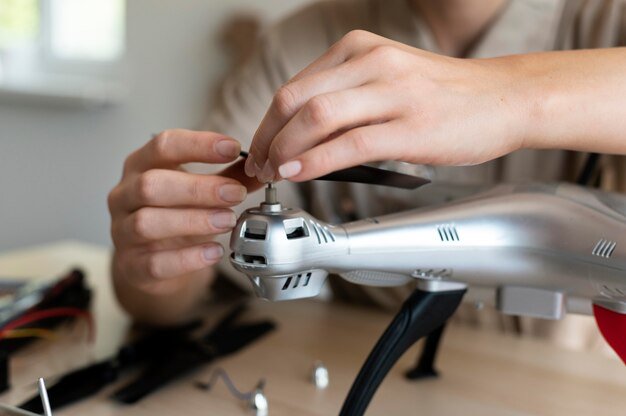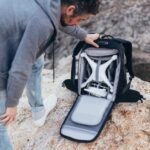Building a micro drone requires careful selection of components to ensure optimal performance, flight stability, and battery efficiency. Below is a comprehensive guide on choosing the right components for a micro drone, including specifications, pros and cons, usage, and purchasing options.
1. Frame

The frame is the foundation of a micro drone, holding all components together. It should be lightweight yet durable to withstand minor crashes.
Specifications:
- Material: Carbon fiber, plastic, or composite
- Size: 65mm to 110mm (measured diagonally from motor to motor)
- Weight: 5g to 20g
- Mounting Holes: Compatible with chosen motors and flight controller
Pros:
- Lightweight construction
- High durability (especially carbon fiber frames)
- Various sizes available
Cons:
- Carbon fiber is expensive
- Plastic frames are less durable
- Size limitations may restrict motor selection
2. Motors

Brushless or brushed motors provide thrust for flight. Brushless motors are more efficient and durable but can be heavier and more expensive.
Specifications:
- Type: Brushed (coreless) or Brushless
- KV Rating: 6000KV – 20000KV
- Weight: 2g to 5g per motor
- Voltage: 3.7V – 11.1V
Pros:
- High-speed performance
- Lightweight options available
- Efficient power consumption
Cons:
- High KV motors drain battery faster
- Brushless motors require electronic speed controllers (ESCs)
3. Propellers

Propellers generate lift and influence drone maneuverability.
Specifications:
- Material: Plastic, nylon, or carbon fiber
- Size: 31mm – 65mm
- Blade Count: 2-blade, 3-blade, or 4-blade
Pros:
- Lightweight and inexpensive
- Available in different shapes for specific flight styles
- Easily replaceable
Cons:
- Can break easily
- Performance varies with propeller type
4. Flight Controller (FC)
The flight controller processes sensor data and stabilizes the drone.
Specifications:
- Processor: F4, F7, or H7 MCU
- Gyro: MPU6000 or ICM20689
- UART Ports: 2-5 for receiver, VTX, and peripherals
Pros:
- Ensures flight stability
- Customizable with firmware (Betaflight, INAV)
- Compatible with various sensors and peripherals
Cons:
- Requires proper tuning
- More advanced models can be expensive
5. Electronic Speed Controllers (ESCs)

ESCs regulate motor speed and power delivery.
Specifications:
- Type: 4-in-1 or individual ESCs
- Current Rating: 5A – 20A
- Protocol: DShot600, Multishot, or PWM
Pros:
- Essential for smooth motor control
- Advanced options support high-speed communication
Cons:
- Adds weight to the build
- Can overheat with excessive current draw
6. Battery and Power System
The battery provides power to all components.
Specifications:
- Type: LiPo (Lithium Polymer)
- Voltage: 1S (3.7V) to 3S (11.1V)
- Capacity: 250mAh – 850mAh
- Discharge Rate: 30C – 80C
Pros:
- High power output
- Lightweight options available
Cons:
- Short lifespan
- Requires careful charging and handling
7. Radio Transmitter and Receiver
The transmitter and receiver enable remote control of the drone.
Specifications:
- Frequency: 2.4GHz
- Protocol: FrSky, FlySky, Crossfire, ELRS
- Channels: 4+ for drone control
Pros:
- Long-range control options available
- Wide variety of transmitters for different budgets
Cons:
- Requires proper binding and configuration
8. Camera and Video Transmission (FPV System)

FPV (First-Person View) cameras allow real-time video streaming for an immersive flight experience.
Specifications:
- Camera Resolution: 600TVL – 1200TVL
- Video Transmission: Analog (5.8GHz) or Digital (DJI FPV, HDZero)
- Power Output: 25mW – 200mW
Pros:
- Provides real-time video feed
- Various resolutions available
Cons:
- Adds weight to the drone
- Higher power output can drain the battery faster
9. Where to Purchase
Here are some recommended online stores for purchasing micro drone components:
- Banggood – https://www.banggood.com/
- GetFPV – https://www.getfpv.com/
- RaceDayQuads – https://www.racedayquads.com/
- Rotor Riot – https://www.rotorriot.com/
- BetaFPV – https://betafpv.com/
- Amazon – https://www.amazon.com/ (for generic components and tools)
How to Use & Assembly Guide
- Assemble the Frame: Secure the motors and attach the flight controller.
- Install the Motors: Connect motor wires to the ESC.
- Mount the Flight Controller: Ensure proper orientation and firmware configuration.
- Connect the Power System: Attach the battery connector and voltage regulator.
- Set Up the FPV System: Mount the camera and transmitter for FPV flying.
- Bind the Transmitter & Receiver: Ensure a proper connection and range test.
- Calibrate and Test: Check flight stability before full operation.
Watch Video for more information:
Conclusion
Choosing the right components for a micro drone is crucial for achieving desired flight characteristics. Selecting quality parts ensures durability, stability, and performance. Carefully balancing weight, power, and features will help build an efficient and enjoyable micro drone.



